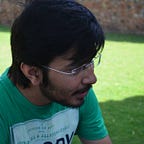Know how a google designer thinks and creates design for billion of users
Learn about his work and get to know his design thinking.
So let start ! what’s your background, and what are you working on ?
I’m a designer with around 12 years of dedicated design and research experience in the tech field. I’m currently a Senior Product Designer at Google working with the Next Billion Users (NBU) group and helping build products thinking of the next billion users (across countries like India, Indonesia, Nigeria, and Brazil) first.
What motivated you to be in this field/career ?
Creativity, lateral thinking, problem-solving and doing all this together in a meaningful way.
What went into building your skill set through which you are making a living right now ?
As a product designer, one needs to be focused on holistic thinking, problem-solving and balance it well with being highly detail focused. I always believe that one needs to be good craftsman first to become an artist. So, initially I was highly focused towards understanding and getting details right — which takes hours and hours and years of practice. Alongside, I always kept nurturing thinking of systems, connecting the dots from research-strategy-technicality angles and ultimately with ample experience, was able to transition to a holistic creative problem-solver. Now, I feel that’s what I get paid for — the perspective and approach I take to solve complex multi-dimensional problems with simple UX.
As a Designer, it is great to work in a company like “Google” as it actually value designers. How has your experience being in google till now ?
Yes, it’s great to work in an environment where design is valued and a designer is looked as an equal stakeholder. Google definitely has the environment where UX — design and research, are highly valued and looked up to make the products follow the user’s needs and aspirations.
My experience has been very positive all through my 6 years at Google. I started my Google career working on Emerging markets (EM) products where the focus was on enabling an accessible, relevant and sustainable Internet ecosystem in Asia-Pacific, Latin America, Sub-Saharan Africa, Middle East and North Africa. This involved the UX team to show the way in understanding the needs of the target users and coming up with designs which worked balancing technical constraints (like Internet bandwidth) and forward-looking concepts. Now, I’m working on similar initiatives with a newer perspective at the NBU group. My team helps in building global products which are first focused on new Internet users or potential next billion users who are now adopting technology in their everyday life.
A few years back at YouTube, I led the design of YouTube Search which needed even a designer to be highly data-driven in evaluating designs for various identified problems and scenarios. Yet, UXers were looked up to be the ones showing the vision of the ideal use-cases for better use of video search.
Above all, designers are not just passionate but also highly compassionate beings. At Google, you tend to be the ones who connects the team together and create an amazing “cool” culture of respect and fun.
People who are becoming designer they always have some companies in their mind’s which they want to work for and google is one of them ? So What does it takes for a designer to work in google or get recruited as one of the designer ? Can you describe your recruitment process to with us also. ?
If you are applying for a designer role at Google, make sure you are thorough with your basics. We are constantly seeking ones who have great problem-solving abilities, love playing with ambiguity and complexity, are risk-takers and above all, excellent at the crafting meaningful designs. One doesn’t need to be a genius :) …but needs to have a clear balance of above aspects to be a great designer and team-player. How we hire at Google is detailed out here https://careers.google.com/how-we-hire/
What are the biggest challenges you’ve faced and obstacles you’ve overcome in your field ? If you had to start over, what would you do differently?
Convincing engineers to build my designs the way I want especially when the users agree (and research shows that) — I’m sure this is the biggest challenge for every tech designer. If I had to start over, I would love to first try and build better work relationships with my engineers and other stakeholders. Also, a designer needs to educate the team a lot about design and UX. Sometimes, one does need to wear an activist’s hat and fight for what users want and at other times be sympathetic to technical constraints and design accordingly. All this can be accomplished when the team trusts you and believes what designs you being to the table are best considering everything.
Do you feel websites like Dribbble and Behance are actually good platform for designers for getting work for them. As we researched you are not that much active on them and also many designers feel its not good for getting work in UI/UX field as design posted on these websites cannot be developed ?
Yes, I feel they are great platforms for inspiration and showcasing of one’s work. Also, a lot of vision work there is of great quality and can help a designer learn and strength his/her basics. I’m afraid I’m not to share much there (due to confidentiality of my work) and also not much active overall. I feel these destinations should be looked at as good references and I’m sure over time, these destinations will predominantly carry “developable” designs.
Where can our users go to learn more about you ?
Want to learn from professionals experience and ask them questions ?
You can join our newsletter where you can get to know about professionals and also ask questions just by filling this form.
Link for the form= https://goo.gl/forms/zzVYLtXXkLntTkTt2
Follow us on Linkedin, Instagram ,Twitter and Facebook
